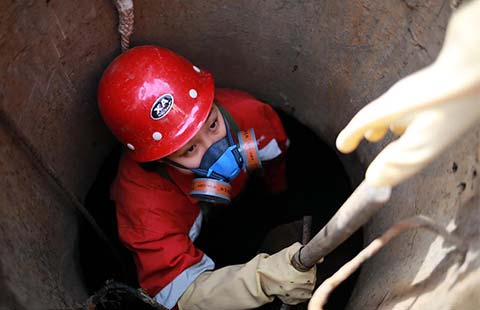Overdue loans pile pressure on lenders
By Wang Xiaotian (China Daily) Updated: 2012-09-21 09:50
Chinese banks' asset quality came under increased pressure in the first half as overdue loans rapidly piled up, according to a report released on Thursday by PricewaterhouseCoopers International Ltd.
China's top 10 lenders' outstanding overdue loans, an indicator of future non-performing loans, or NPLs, reached 489 billion yuan ($77.6 billion) by the end of June, up 112.9 billion yuan from six months earlier, it said.
"That's much higher than our previous expectation, signaling considerable pressure on banks' asset quality," said Richard Zhu, a financial services partner at PwC.
The banks' ratio of overdue loans also increased from 1.06 percent to 1.28 percent.
The 10 listed banks include the five largest State-owned lenders - the Industrial and Commercial Bank of China Ltd, China Construction Bank Corp, Bank of China Ltd, Agricultural Bank of China Ltd, and Bank of Communications Co Ltd. The other five are major joint stock banks - China Merchants Bank Co Ltd, China Citic Bank Corp, Shanghai Pudong Development Bank Co Ltd, Industrial Bank Corp Ltd, and China Minsheng Banking Corp Ltd.
Concerns over deteriorating asset quality are rising. Lenders extended record high new yuan loans last month compared with any previous August as the government seeks financial support for new rounds of investment projects intended to spur economic growth.
Although overdue loans are increasing at a faster pace, it's hard to say how many of such loans will finally turn sour, said Margarita Ho, a partner of PwC China Financial Services.
"It's up to the risk-management experience they (the banks) accumulated, which I think has obviously improved in the past years. What's more, by the year end the increase in such loans may be more moderate, given they have to meet various regulatory requirements at that time," she said.
The non-performing loan ratio among the top 10 banks in the first half declined by 0.02 percentage points blow six months earlier, but the total outstanding NPLs grew by 5.3 billion yuan to 356.7 billion yuan, said the report.
The Yangtze River Delta and western China had the highest level of NPLs in the first half. Bad loans in the Yangtze River Delta surged 21 percent.
Loans to the manufacturing sector accounted for 40 percent of the soured loans, followed by loans to the wholesale and retail sector. NPLs to retailers surged by 34 percent in the first half.
"We noticed NPLs among banks are rising in China, but it will be fine given the lenders are already very well prepared for the thorny scenario," said Eric Raynaud, CEO of BNP Paribas Asia-Pacific. The bank currently holds a 12.7 percent stake in Bank of Nanjing Co Ltd.
"Following reform, asset or liability management has become increasingly important for banks. Provided listed banks effectively manage the above risks and develop appropriate measures in response to the changing trends, they will be well positioned in the new competitive environment," Ho said.
While uncertainties over asset quality loom large, lenders' profitability will be further confined by the government's attempts to liberalize interest rates and slower fee income growth, indicating that the writing off of these bad loans will be more difficult.
The 10 banks posted a combined net profit of 513.2 billion yuan in the first half, a 17 percent increase year-on-year, said the report. But the rate of growth has slowed considerably from 34 percent during the same period in 2011, it said.
The growth would probably slow down to a level between 10 and 15 percent in the next 12 months, as the interest spread narrows, said Jimmy Leung, PwC China banking and capital markets leader.
China's central bank has made two asymmetric cuts in deposit and lending interest rates since June, and announced that deposits were allowed to float upwards, which was viewed as a historical change to the uniform deposit rate scheme long practiced in the banking industry.
"What this means is that it's no longer viable for banks to take in deposits at low costs. In the future, it would be crucial for banks to improve their asset and liability management in order to cut capital costs," said Leung.
The central bank's recent effort to liberalize interest rates in June and July was almost not reflected in the interim results.
The average net interest margin, a key measure of banks' profitability from lending, stood at 2.75 percent, a slight increase compared to the end of 2011, he said.
wangxiaotian@chinadaily.com.cn
- Joint stock banks urged to strengthen risk controls
- 'Shadow banking' financing explodes in past decade
- New yuan loans hit August high
- Moody's warns on Chinese banks' asset quality
- Agricultural policy bank's NPL ratio down to 1.26%
- Details of Wenzhou financial reform to be out next month
- Banks' NPL figures 'don't add up'
- Commercial banks' NPL ratio below 1%
- Dutch bank opens first branch in Shanghai
- Foreign trade target not yet set despite economic growth
- Deputies, members share their views on five-year plan draft
- China's steel industry strives to tackle overcapacity
- Official defends credibility of Chinese economic data
- China's top legislature to strengthen supervision over govt budgets
- Chinese shares close lower - March 9
- Chinese mobile phone suppliers eye Indian market
















